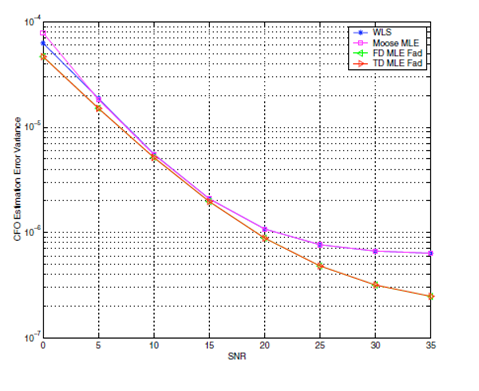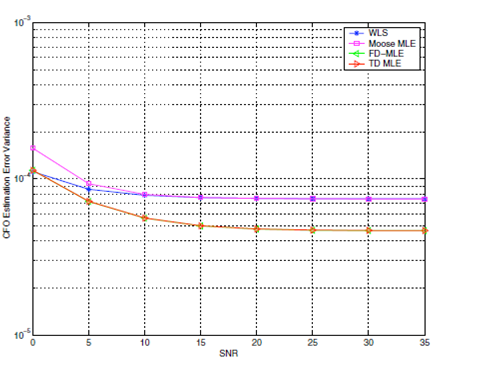Aims & Objectives
Aims:
To estimate the carrier frequency in maximum likelihood conditions across OFDM systems using MATLAB simulation.
Objectives:
Following are the project objectives
- To understand the concept of OFDM systems and frequency offset estimation methods
- To prepare literature review on existing carrier frequency offset estimation techniques and their corresponding limitations
- To design maximum-likelihood carrier frequency offset estimator across OFDM systems
- To simulate the proposed technique in MATLAB
- To document the results and observations.
Results and Explanations:
Simulation results
By the following system parameters such as normalized CFO (sub carrier spacing/ frequency deviation) fo = 0.01, number of sub carriers N = 512, and cyclic prefix size Ng = 52, simulation experiments were performed. In order to simulate the multipath channel under fading and static scenarios with L=12 principal components, the Jakes model was used.
For 400 symbols of OFDM, the variation of estimation error of CFO is calculated, and for all SNR values the results are common on hundred monte-carlo models. The proposed estimator’s performance is compared by the frequency domain of weighted least squares (WLS) approach and MLE scheme which is proposed by Moose. For various SNRs, the variance of CFO estimation error in time-invariant channel is illustrated in a given figure.
In case of static channel, all the four methods are identically performed, expect in low region of SNR, where the suggested TD-MLE is found to perform much better. Also, in this case observe that the suggested method of FDMLE minimizes to MLR method proposed by Moose, as a result of this they both possess the same implementation. In fading channels case, the solutions are displayed in both the figures represented below through 0.005 normalized Doppler frequency of fast fading and 0.005 (slow fading) normalized Doppler frequency respectively.

Fig: Comparison of performance of various estimation schemes of CFO in case of slow fading channel, with normalized Doppler frequency of 0.005.
The figure represents that both the suggested schemes such as TD-MLE and FD-MLE produce comparable results, and provide enhanced performance when compared to WLS approach and Moose MLE under each SNR, mostly in case of higher SNR regions.

Fig: Comparison of performance of various estimation schemes of CFO in case of fast fading channel, with normalized Doppler frequency of 0.005.
The figure represents that each and every scheme viewed to possess the implementation floor in high and SNR moderate regions, and a lower error floor is contained by the suggested MLEs when compared to WLS scheme and Moose MLE. The reason for enhancement of performance is that the fading is considered by the suggested estimators.
Conclusion:
For the estimation of CFO, the two estimators of maximum likelihood are proposed in the conditions of the fading channel. In the design of this estimator, the considering factor is coefficient of fading. In this there is a special case about the static channel and in this the coefficient of fading is a=1. Under the conditions of the static channel, scheme of WLS and moose MLE these are comparable with the performance of the proposed schemes, these are shown by the simulations.
Under the conditions of fading, comparing to the conventional schemes this proposed one is better. The reason for this is considering the fading factor of the proposed schemes. For the great accuracy of the estimation, the complexity reduction is the great advantage of the scheme TD-MLE. In this estimation of the CFO, use the dominant multi paths. So, the CFO is used for the fading channels by the proposed estimators. In OFDM systems reduced the ICI; by this the performance of the system is increased.
